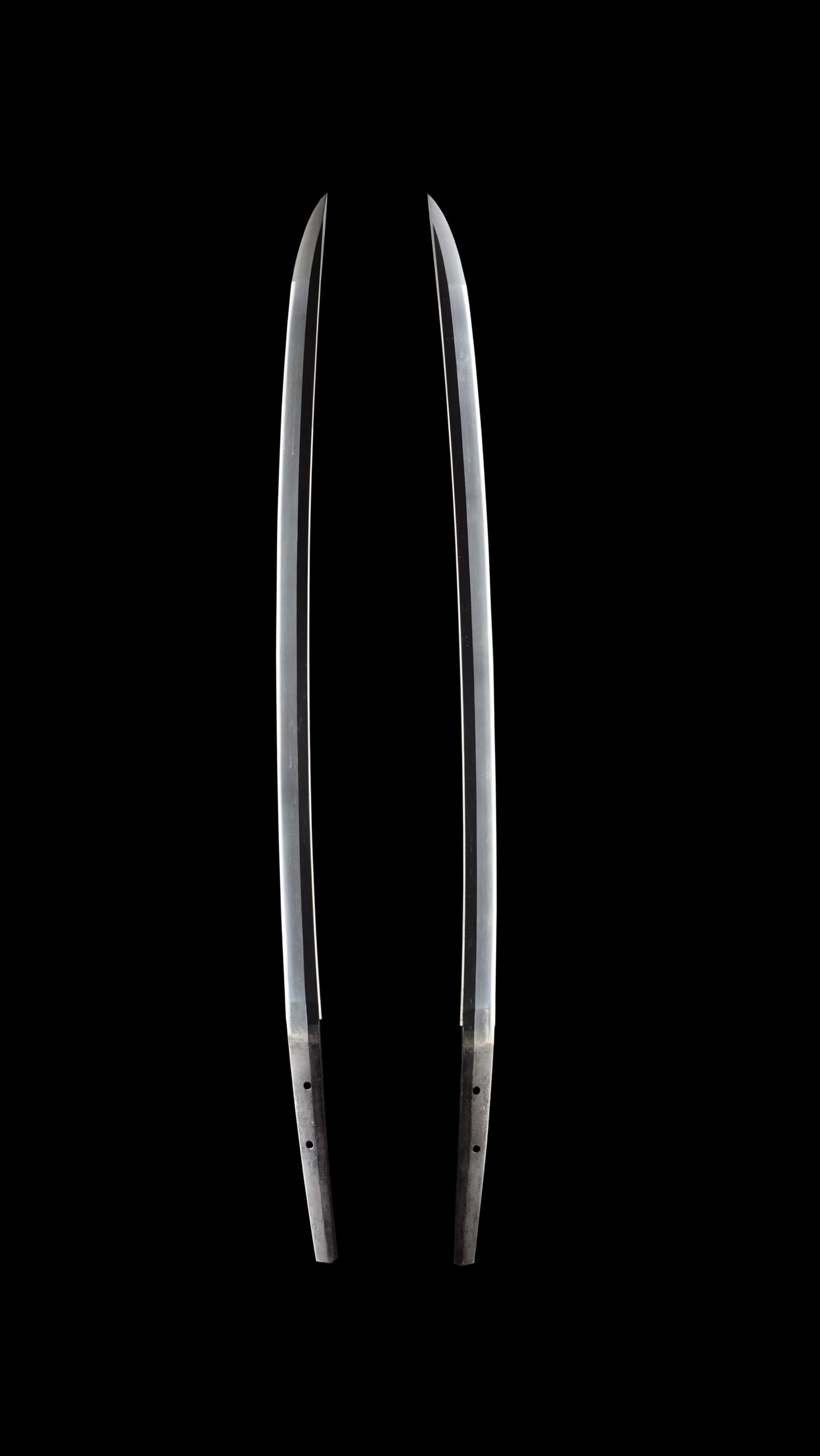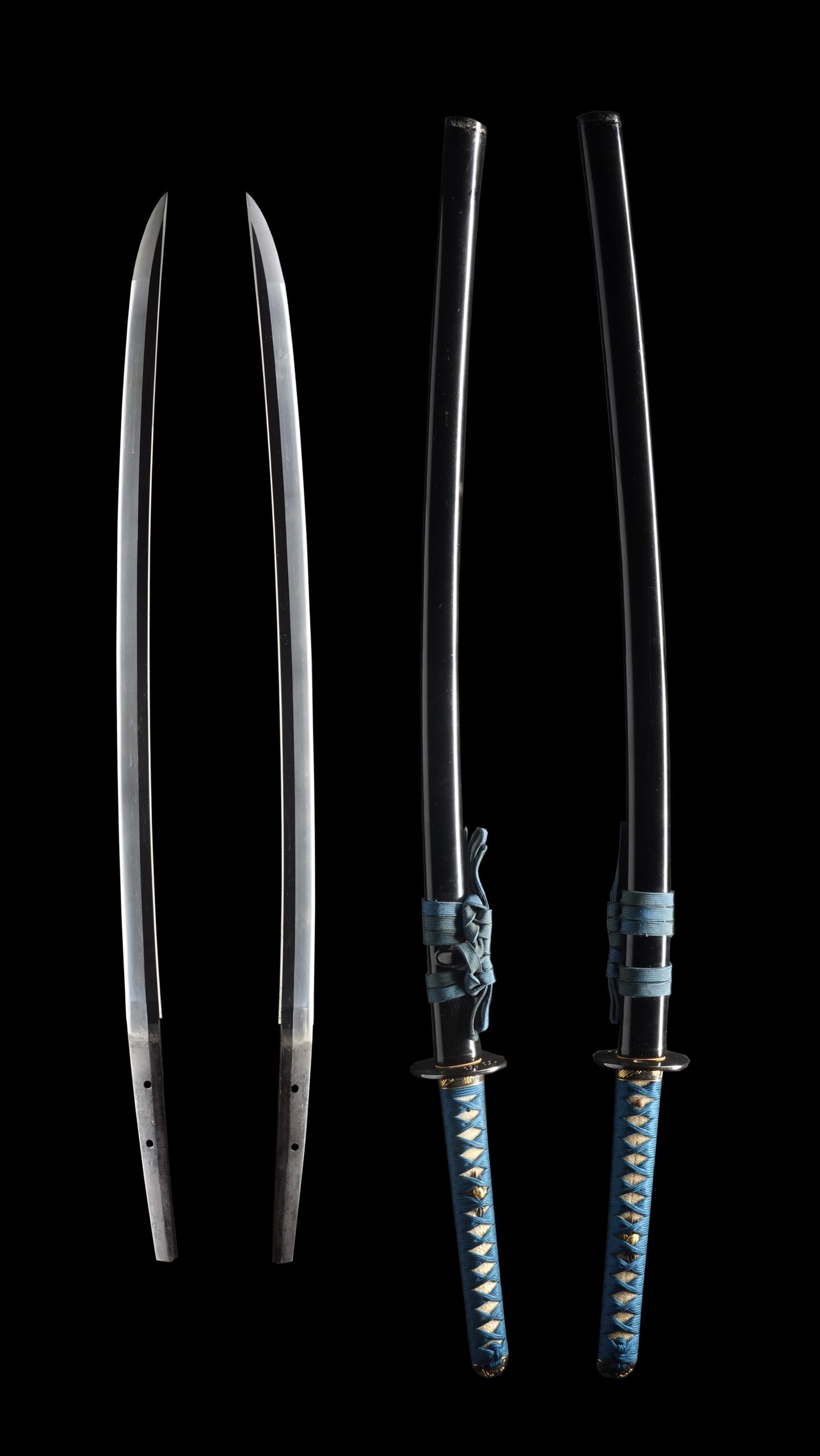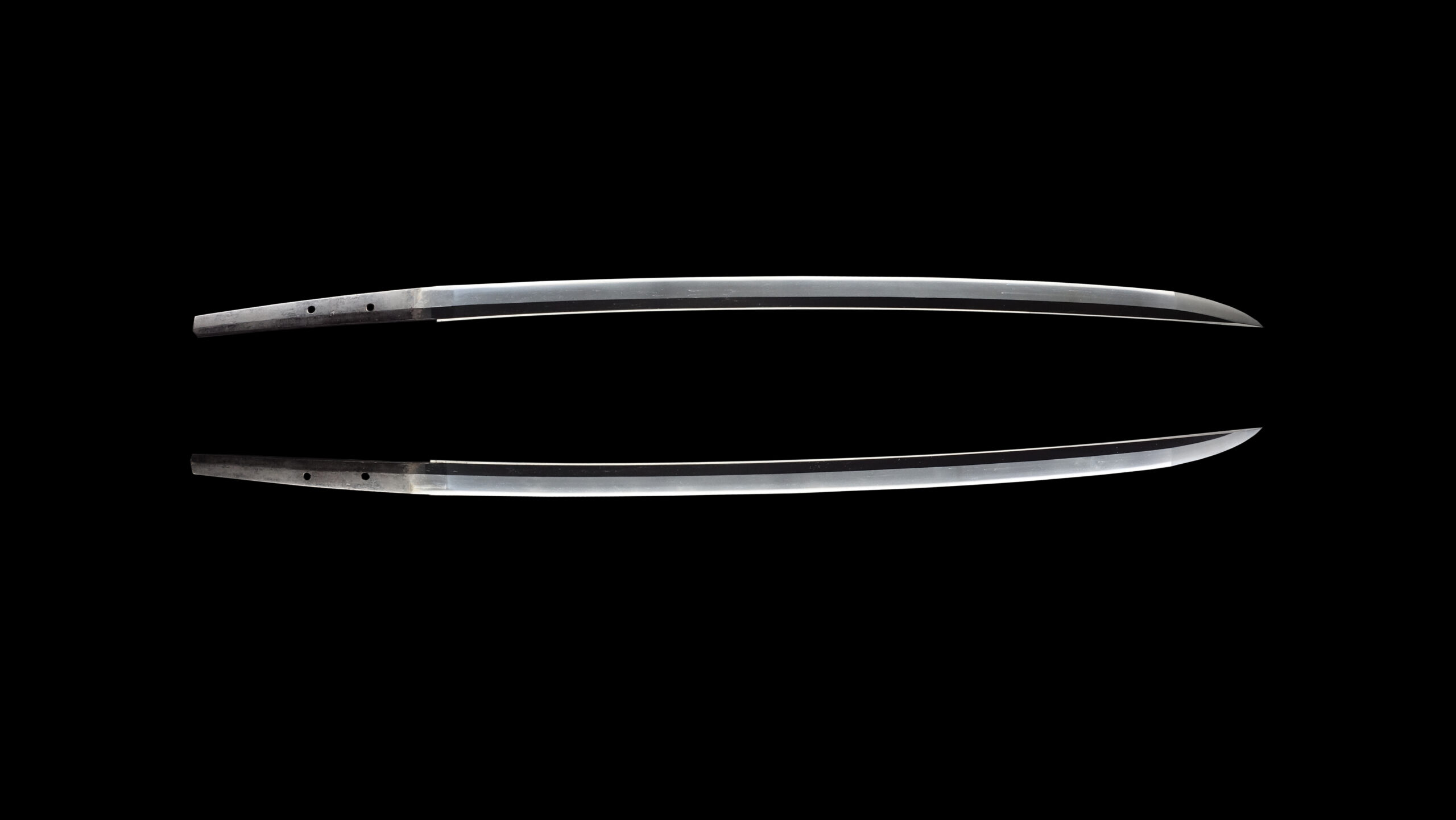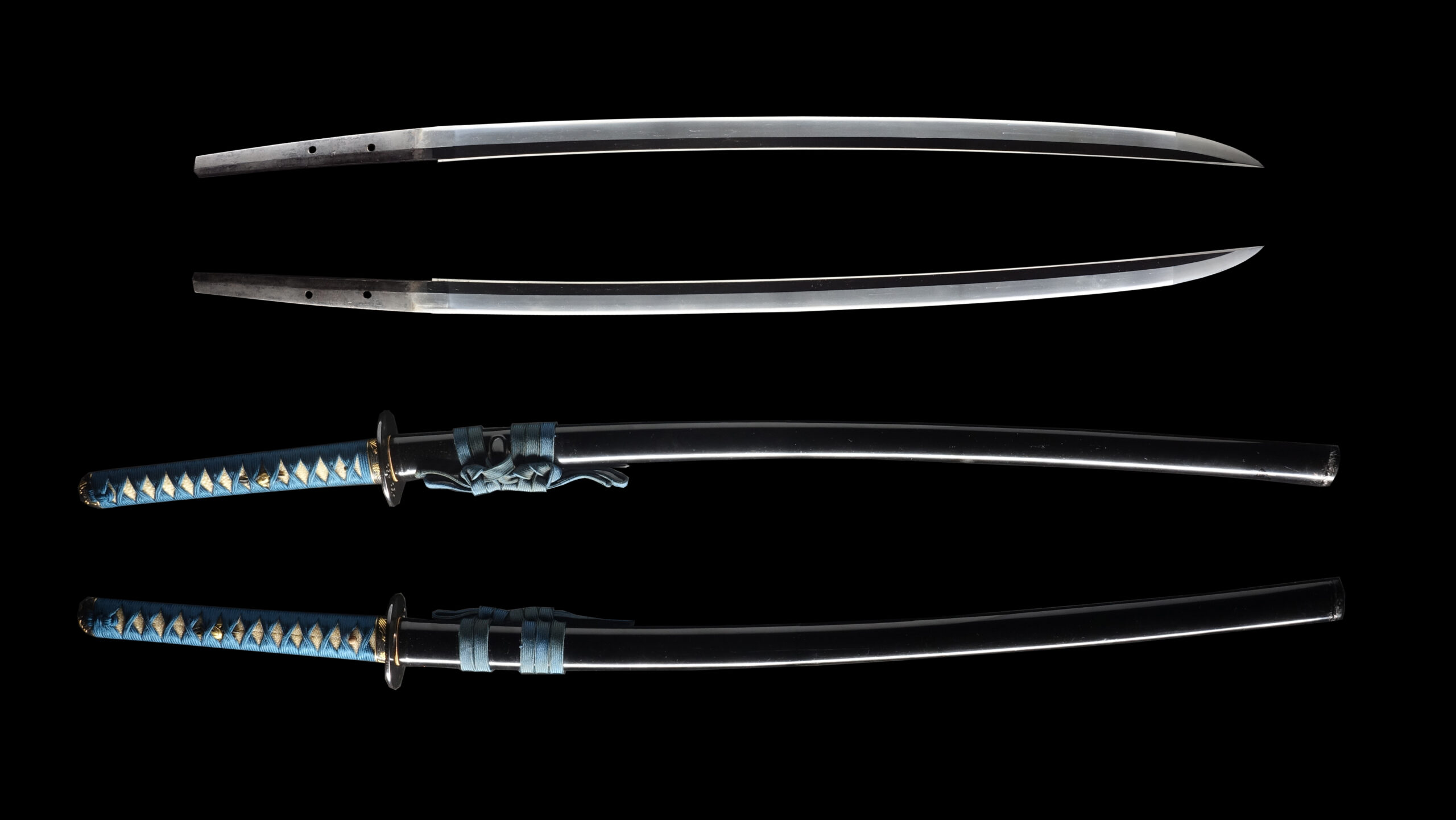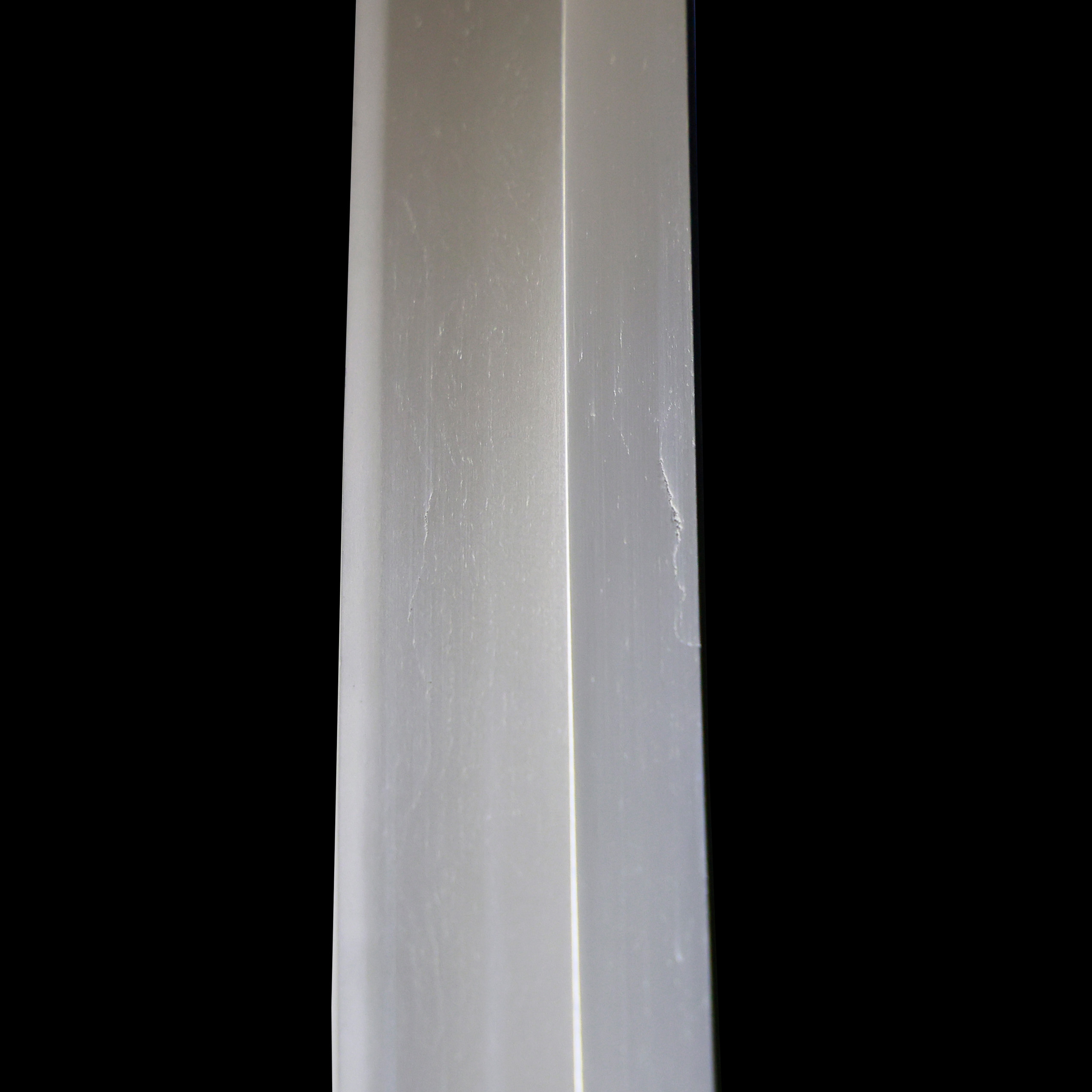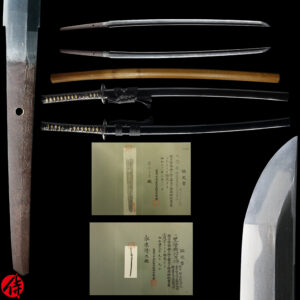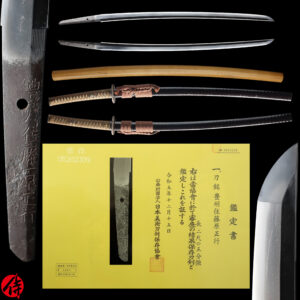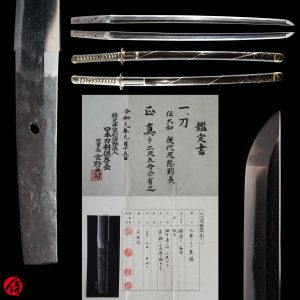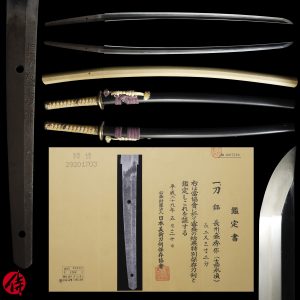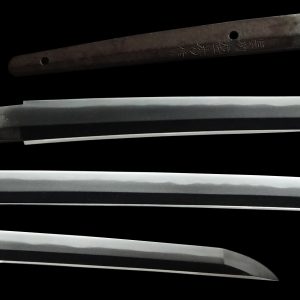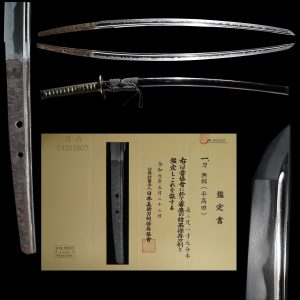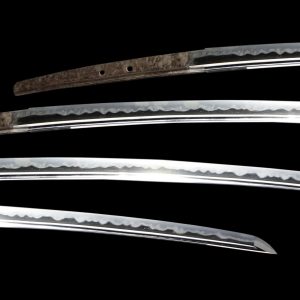Antique Japanese Sword Katana attributed to Hokke Kaneyasu with Tokubetsu Hozon Certificate
【Description】
Summary
This blade is attributed to Hokke Kaneyasu (法華兼安) by the NBTHK, one of Japan’s most respected Japanese sword appraising organizations. Kaneyasu (兼安) is one of the most renowned swordsmiths of the Hokke school, a prestigious tradition that flourished during the late Kamakura to Nanbokucho period (late 13th–14th century). It is said that Kaneyasu was active during the mid Nanbokucho period (Late 14th century). The Hokke school was based in the Ashida area of Bingo Province, which corresponds to present-day Hiroshima Prefecture.
It is said that those who lived in Ashida area were followers of the Nichiren sect, and Hokke swordsmiths often forged blades for the politically powerful Buddhist priests. They needed many weapons as there were many political rivalries between influential temples. They required strong weapons like swords to protect themselves. Hokke swordsmiths met their requests and made excellent quality blades.
It is believed that the school was founded by Kokubunji Sukekuni (国分寺助国) in the late Kamakura period (Approx. 1329). Sukekuni was originally from Bizen province (today’s Okayama prefecture) and belonged to Bizen Ichimonji school, one of the most prestigious schools during the Kamakura period. Sukekuni was the father of Mihara Masaie (三原正家). Masaie was the founder of Mihara school, another prestigious school in the region.
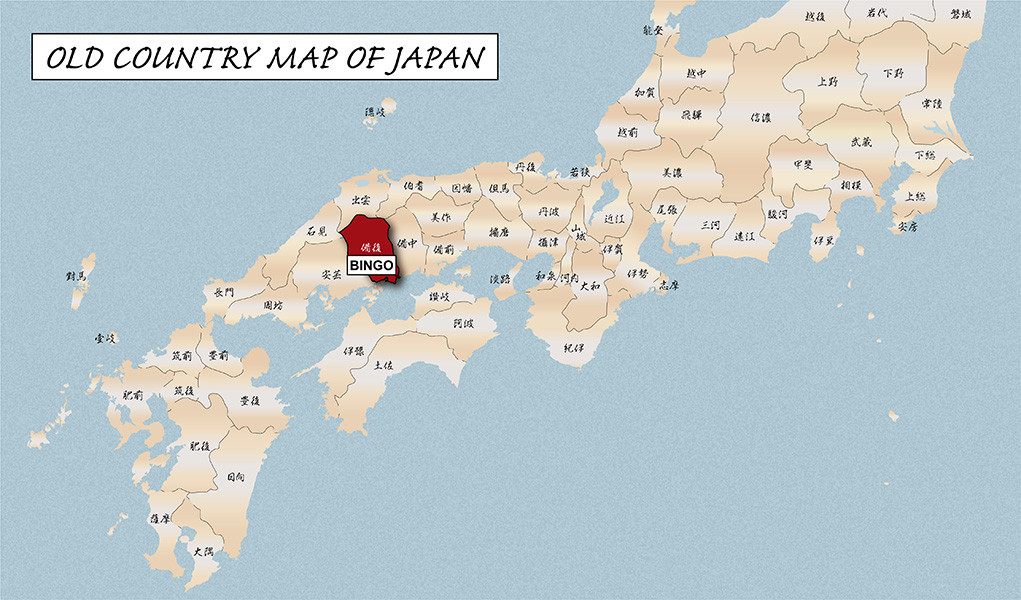
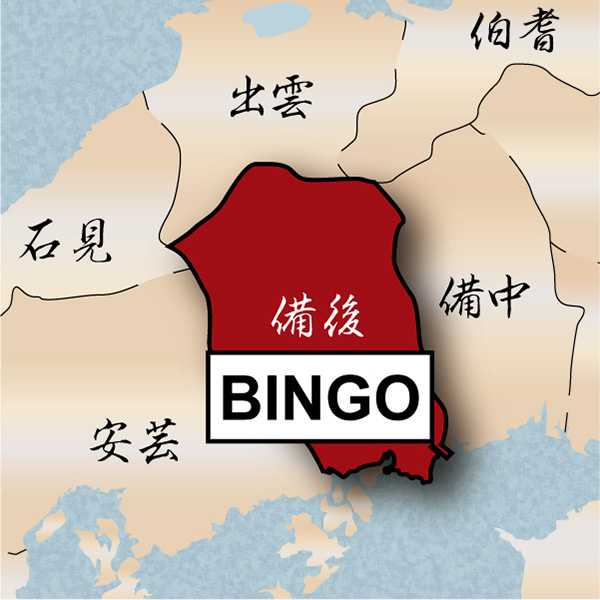
It is appraised as a Tokubetsu Hozon Token(特別保存刀剣) issued by NBTHK(Nihon Bijutsu Touken Hozon Kyokai:日本美術刀剣保存協会). This authentication paper was only given to authentic Japanese swords, especially well preserved and high quality with artistic value.
*Please keep in mind that there is partial black rust and tiny Kitae Kizu on this blade. If you like to see the detailed condition, please feel free to contact us.
【 Blade】
Cutting Edge Length(Nagasa):67.5 cm (26.5 inches)
Curvature(Sori):1.8 cm (0.70 inches)

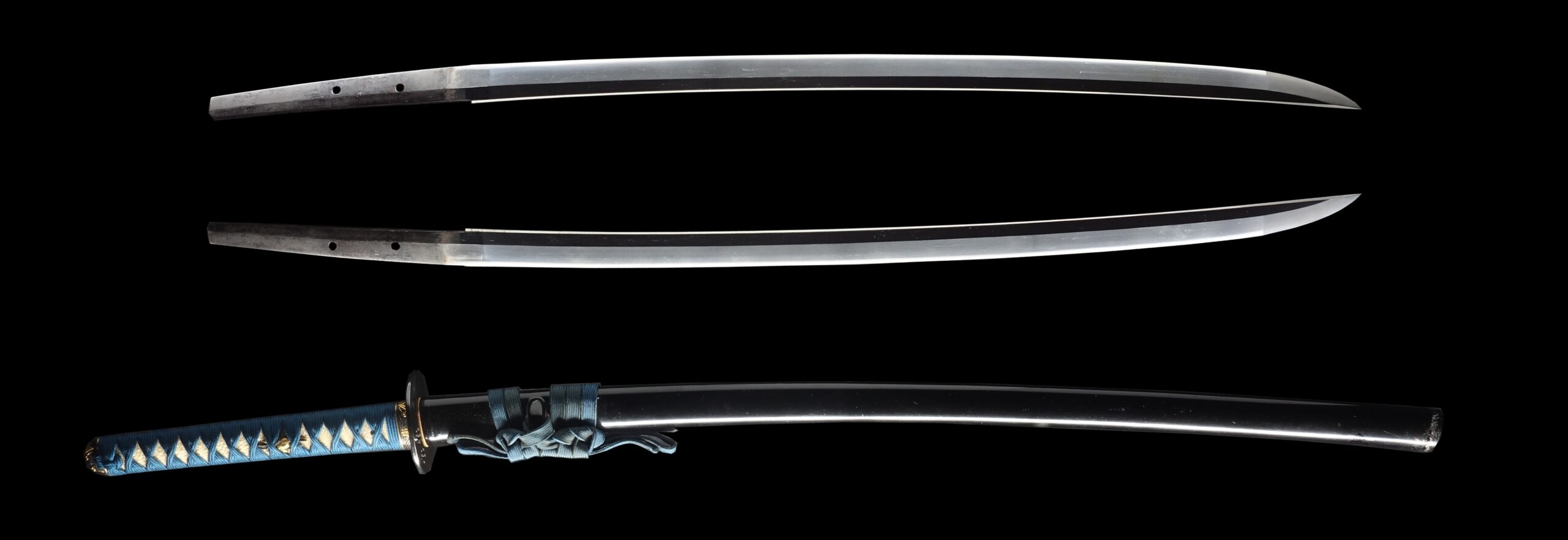
Hamon:
The crystalline structure which forms along the cutting edge of a blade as a result of the hardening process
Jimon(Jihada):
visible steel surface pattern created by folding and hammering during forging process

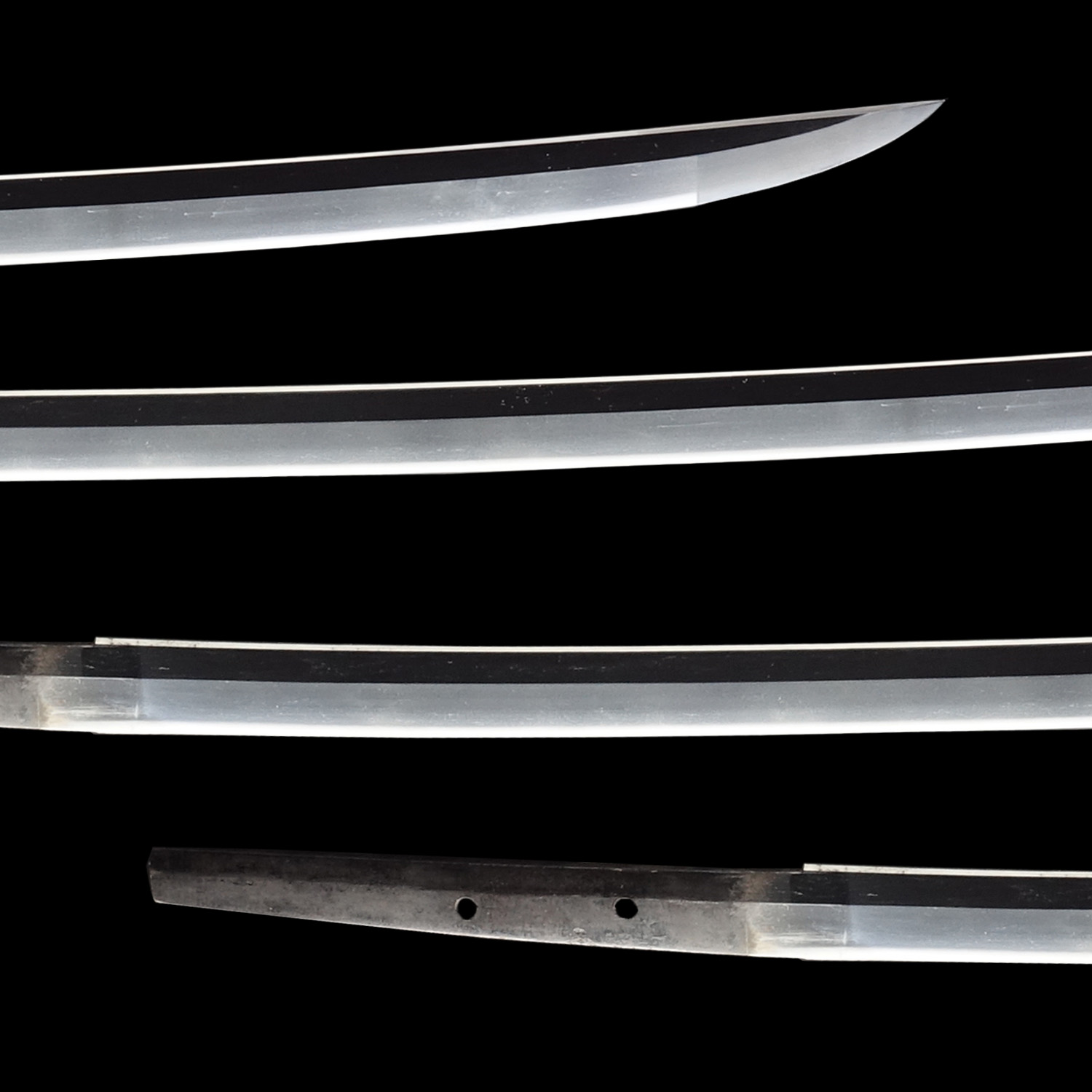
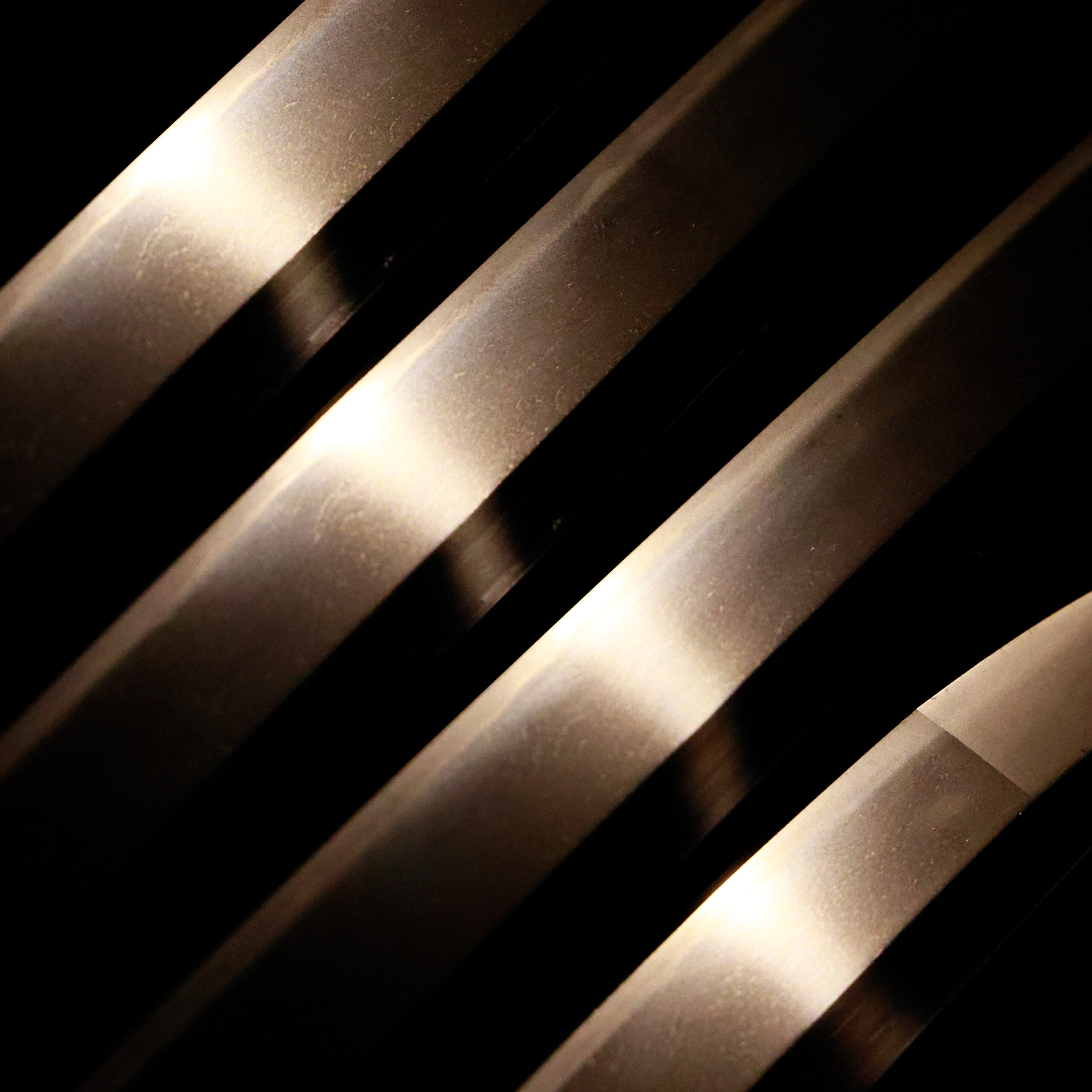


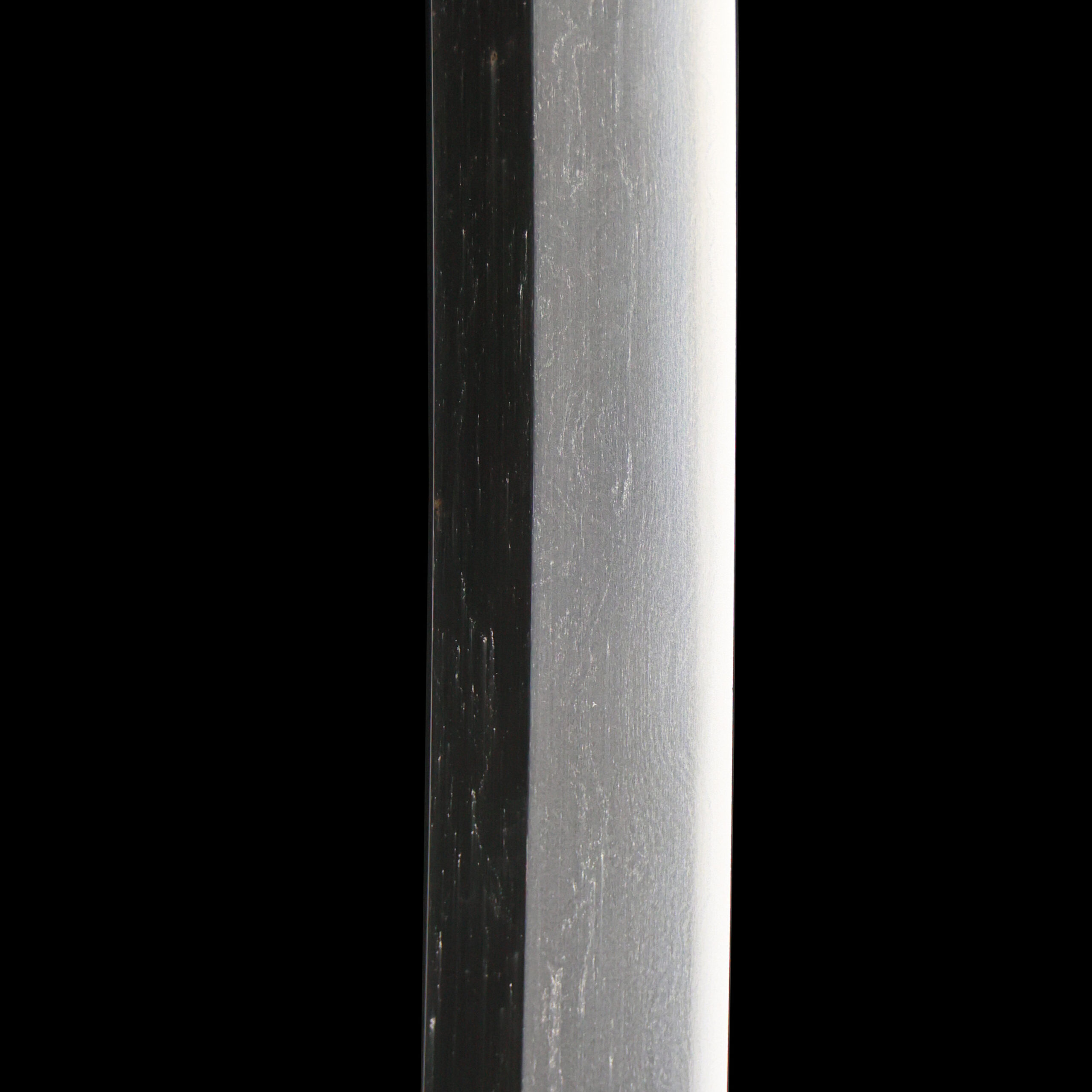
Kissaki:Kissaki is the tip of the Japanese sword.
This katana features an ōkissaki (大切っ先), or “large point,” which is a distinctive characteristic often seen in long swords (大太刀, ōdachi) from the Nanbokuchō period (14th century).
The ōkissaki refers to a longer-than-usual blade tip, designed for powerful cutting and extended reach. From the late Kamakura through the Nanbokuchō period, Japan saw the rise of large, imposing weapons such as ōdachi, naginata, and nagamaki—often featuring broad blades and long kissaki. These were ideal for mounted combat, where heavily armored samurai engaged in one-on-one battles on horseback.
As battlefield tactics evolved toward the Sengoku period, sword designs became more compact. The curved, long-bladed tachi gradually gave way to the more practical uchigatana, with shorter blades and smaller kissaki, better suited for infantry combat and close-quarters fighting.

Nakago:Nakago is the tang of the Japanese sword.
Japanese swordsmiths left the black rust on the tang because it prevents red rust while the tang is in its handle. And the discoloration of the tang was created over time, and it is a great indicator for a Japanese sword specialist to estimate when the sword was forged.

Koshirae:Koshirae is the mounting of the Japanese sword. There are several parts that consist of Koshirae such as Saya (Scabbard), Tsuka (Handle), Tsuba (Handguard).
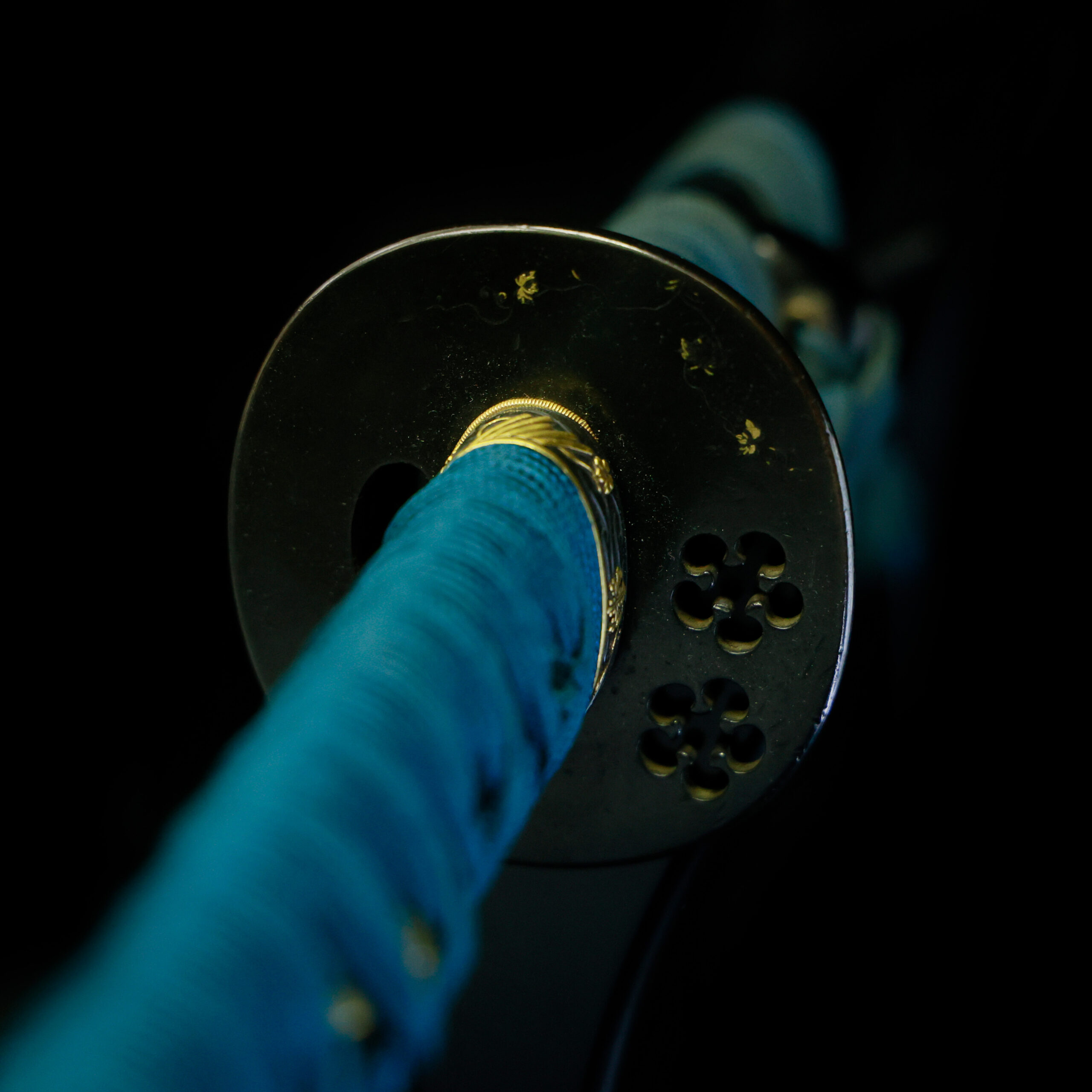
Fuchi-Kashira:A pair of matching sword fittings that cover the upper and bottom parts of its sword hilt.
The design of this fuchi kashira features an elegant combination of ocean waves and the kiri-mon (桐紋, paulownia crest).
The paulownia crest, or kiri-mon, is one of the most iconic traditional motifs in Japan. Historically, it was used by the imperial family and later became associated with the government and authority, especially during the Toyotomi and Tokugawa periods. Today, it’s still used in official emblems, such as that of the Japanese Prime Minister.
The pairing of waves, which represent eternity, resilience, and the ever-changing nature of life, with the paulownia, a symbol of dignity and good fortune, creates a refined and meaningful design. It reflects both a sense of strength and graceful elegance, values that were highly appreciated by the samurai class.
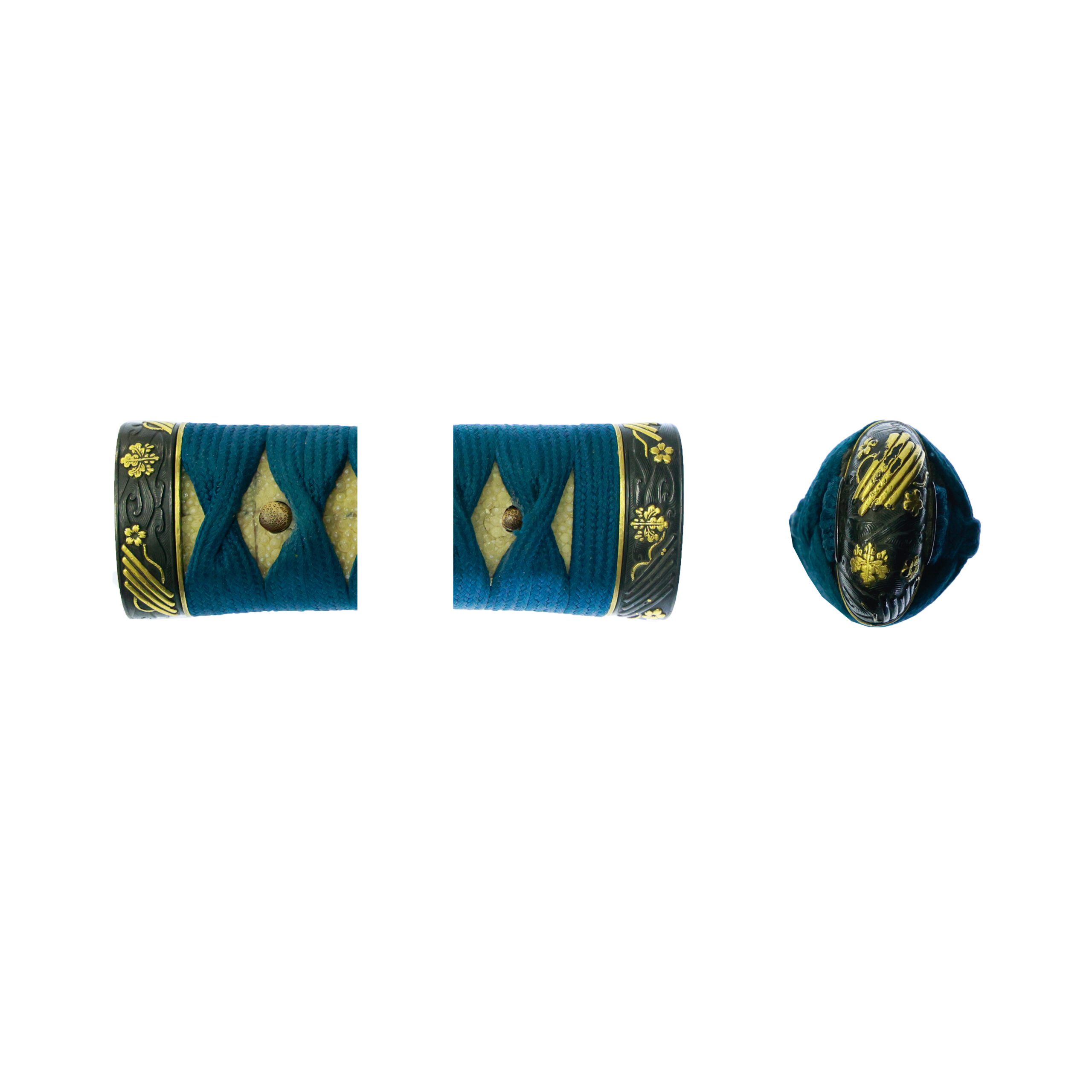
Tsuka and Menuki:Tsuka is the handle of the Japanese sword and Menuki is its decoration.
The motif of this menuki is myoga (茗荷), also known as Japanese ginger. Myoga was introduced to Japan along with shoga (生姜), or common ginger. According to one theory, shoga was once called “senoka,” while myoga was referred to as “menoka” in ancient times. Over time, these pronunciations gradually changed into the modern forms we use today.
Interestingly, myoga shares the same pronunciation as the word myōga (冥加), which means divine protection or blessings from the gods. Because of this association, the myoga motif has long been considered a symbol of good fortune and is often seen at shrines and temples across Japan. It is also a popular design used in kamon (family crests), admired for both its meaning and elegant shape.


Tsuba and Habaki:Tsuba is the handguard for the Japanese Sword and Habaki is the equipment to make the blade not touch its scabbard inside. It prevents the blade from getting rusty and chipped.
The design of this tsuba depicts Japanese apricot blossoms (梅, ume). These flowers begin to bloom in winter, often while snow still clings to their branches, and are therefore seen as a sign that spring is approaching. Like cherry blossoms, they have been cherished in Japan for centuries. People admire their delicate petals, subtle fragrance, and the elegant shape of the tree’s branches—so much so that many traditional poems have been written about them. Because they bloom in the cold season, ume blossoms symbolize perseverance, resilience, and vitality.
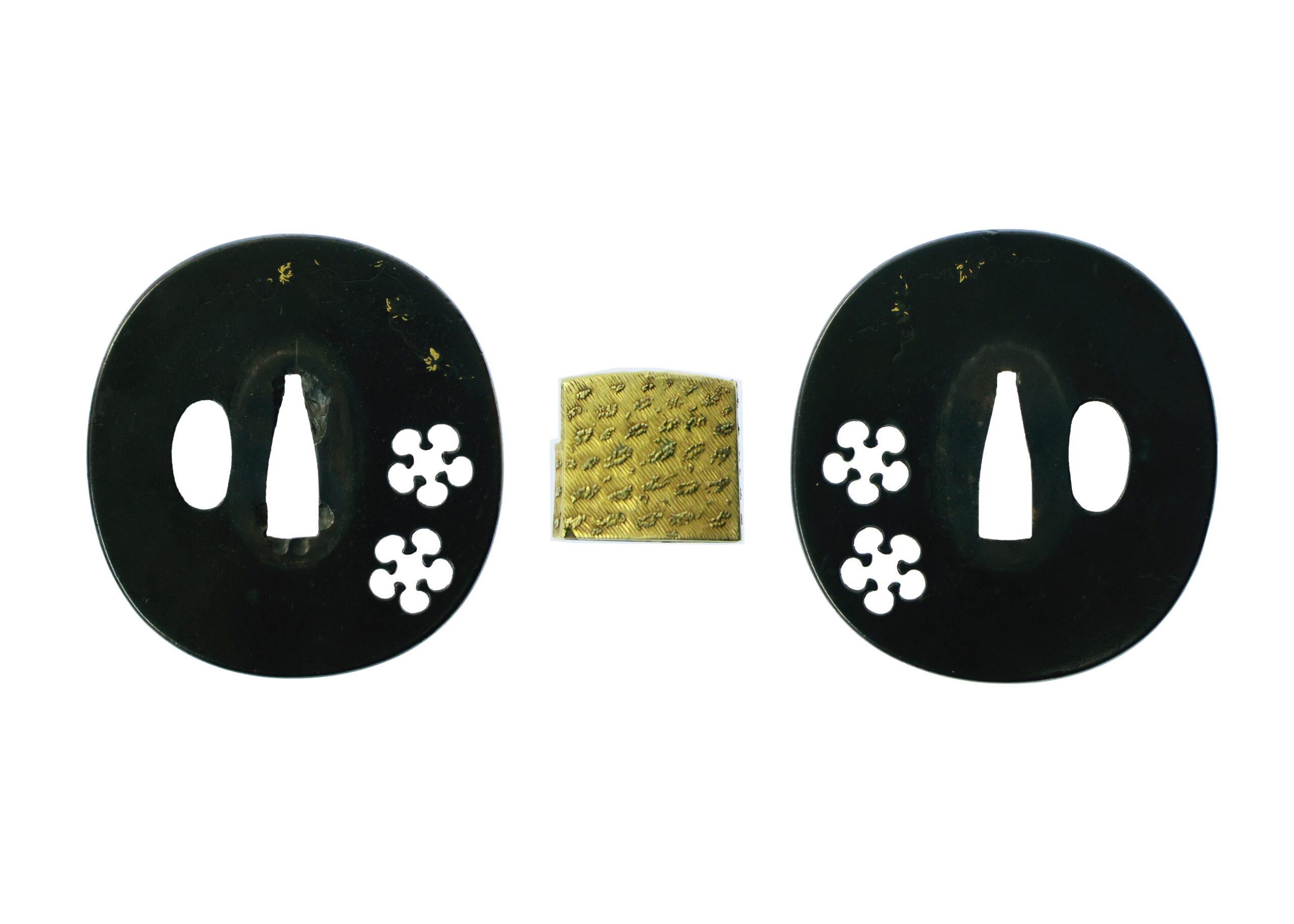
Saya:Saya is the scabbard for the Japanese sword.

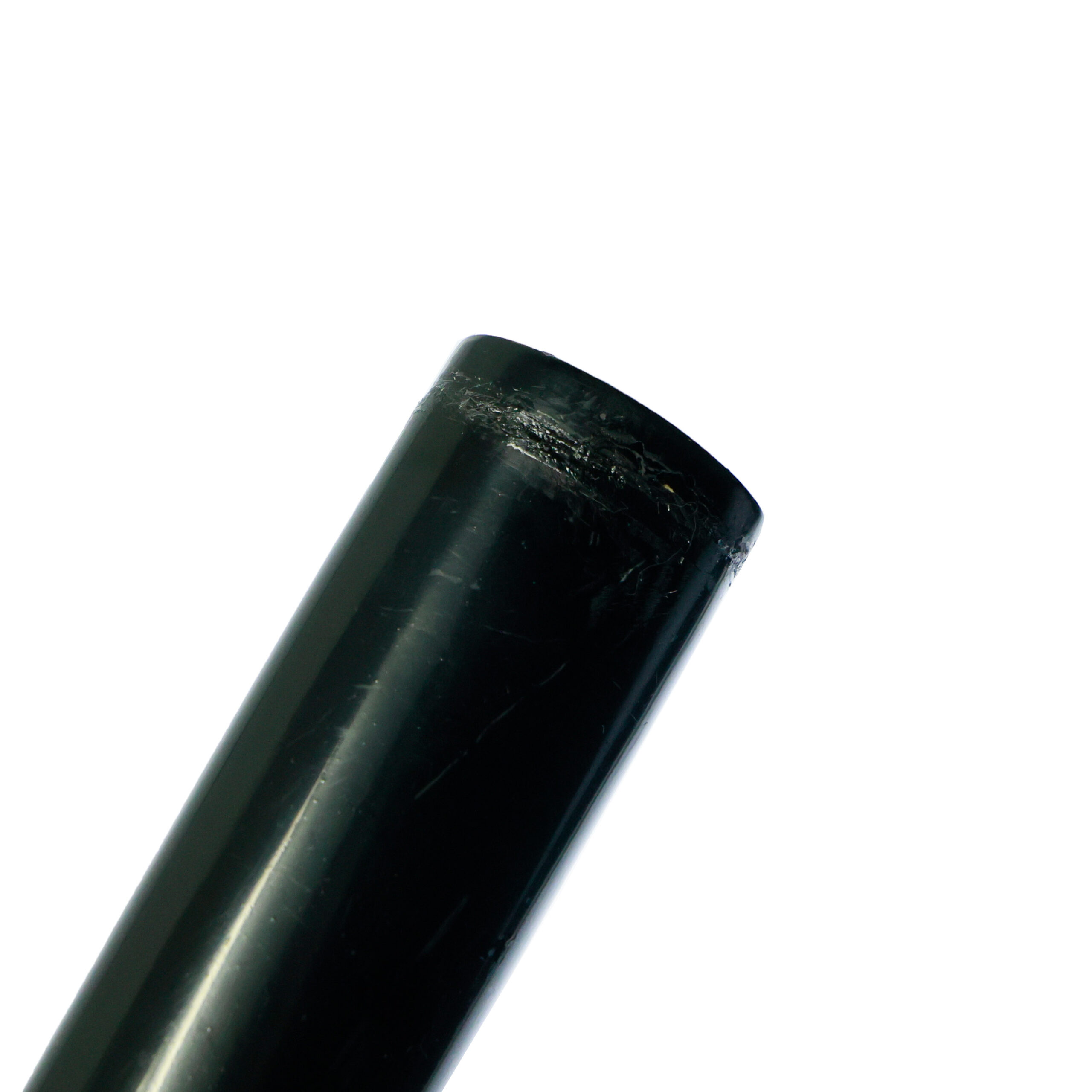
Authentication Paper:NBTHK TOKUBETSU Hozon Certificate for the blade (No. 1023553)
NBTHK, also known as Nihon Bijutsu Touken Hozon Kyokai (the Society for the Preservation of the Japan Art Sword), is one of the oldest Japanese sword appraising organizations in modern-day Japan. They authenticated the blade on December 4th in the 6th year of Reiwa (2024). They appraised it as Tokubetsu Hozon Touken, the blade especially worth preserving for Japanese society. The purchaser will receive this original certificate as well. We can also translate what is written into English and make a PDF file for your record if you request.
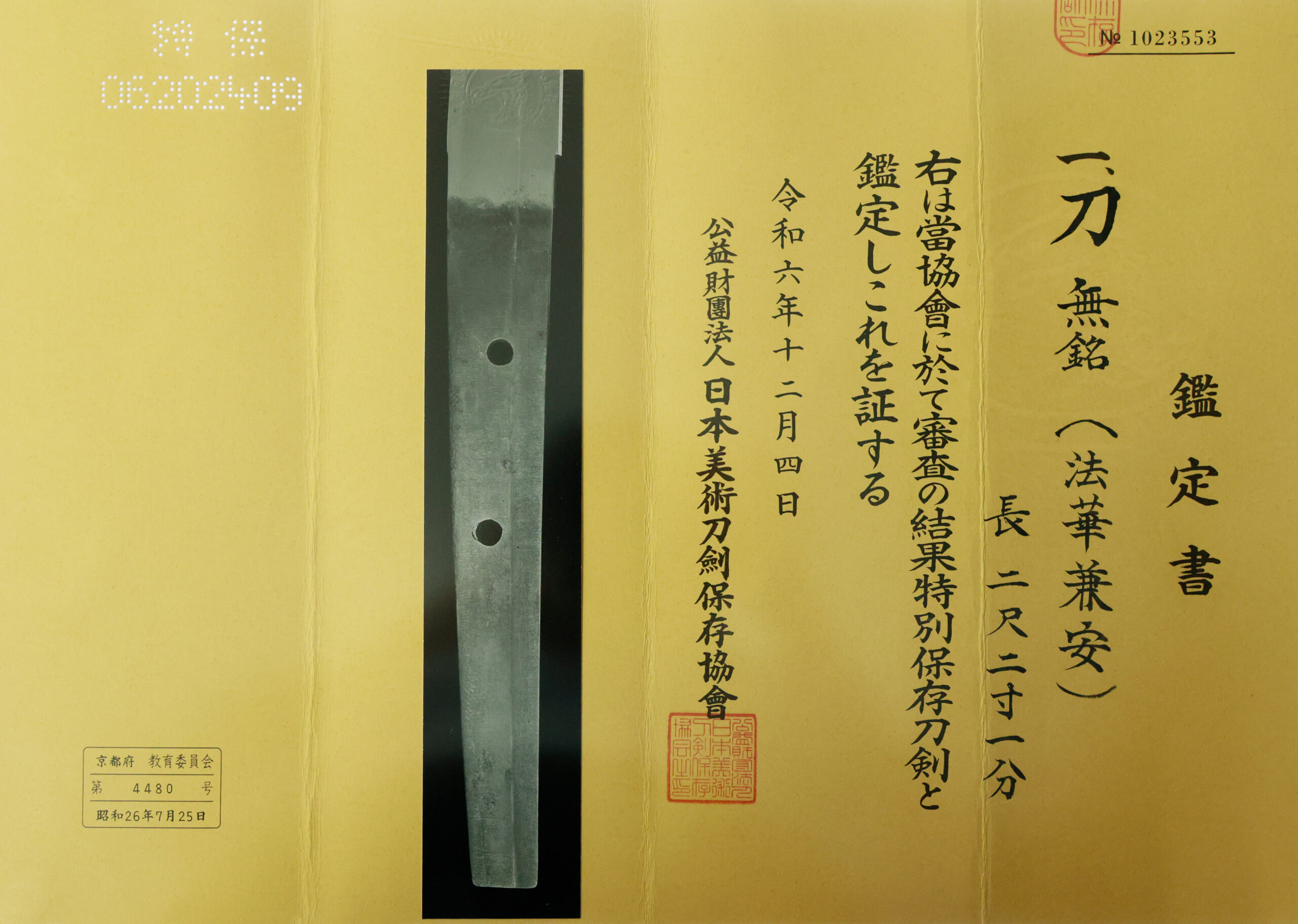
Registration Number : Kyoto 4480
The Board of Education in Kyoto prefecture issued a registration paper for this sword. It is called Jyu Hou Token Rui Tourokusho (銃砲刀剣類登録証). Bunkacho (The Agency for Cultural Affairs) acknowledges a Japanese sword with this paper as a work of art.
The sword needs to be traditionally hand-forged and made of Tamahagane carbon steel to be registered in the system. With this paper, its owner in Japan can legally own an authentic Japanese sword. Based on this registration number, we will apply for its export permit.
This paper will need to be returned to the board of education when the sword is being shipped abroad, but you can receive a copy of it. An English translation of this registration paper is available on request.


—————————————————————–
【About us】
Samurai Museum is located in Tokyo, Japan, exhibiting antique artifacts related to the Samurai history. Samurai Museum Shop is the place for those who are interested in Japanese culture and craftsmanship. We deal with antique Samurai swords/armor, traditional crafts made in Japan and so on.
【Japanese Sword& Export Process】
The Japanese swords we deal with are hand-forged edged swords made in Japan. It was made from the traditional carbon steel called TAMAHAGANE(玉鋼). Samurai Museum is familiar with the proper legal procedure for an antique/ authentic Japanese sword to be exported from Japan. We have sent more than 1000 Japanese swords for the past few years (~2025) to amazing owners who appreciate its historical value.
Each Japanese sword is registered under the Agency for Cultural Affairs and the Board of Education in Japan. They issue a registration paper for each Japanese sword for its owner in Japan to legally possess it. The Japanese sword with its registration paper means it was traditionally hand-forged in Japan.
To legally export the sword from Japan to other countries, we will have to apply for its permit to the Agency for Cultural Affairs(Bunkacho) and return the original registration paper to the Board of Education. It normally takes around 2-4 weeks to receive this permit after submitting required documents. And we would like you to expect at least 1-1.5 months for your order to arrive at your given address after you ordered. For more detailed info, please click here.
It is allowed for residents in Japan to own authentic Japanese swords without a special license as long as they come with registration papers. Please feel free to contact us if you are a resident of Japan, whether temporarily or permanently. We will also assist you when you leave Japan and need to obtain the export permit.
【Payment Method】
We accept payment through Stripe (Credit card), PayPal, Apple Pay or ChromePay, all of which are secure payment methods. Also, you don’t need to make an account on Stripe for the checkout. If you prefer other payment method, please contact us. After confirming your payment, we will apply for an export permit. You may either pay in JPY, USD, AUD, CAD,EUR CHF or GBP. The price is set in Japanese Yen. Prices in other currencies are automatically calculated based on the latest exchange rate.

* If the amount is above 1 million JPY, Stripe or wire transfer will be the only options for payment.
【Shipping】
We have shipped authentic Japanese swords to the USA, Canada, Mexico, Germany , Belgium, France, Finland, UK, Hong Kong, Australia. If you don’t live in these countries and like to order, please contact us first before making a purchase. We offer Free International Shipping as long as we can send antique Japanese swords by EMS.
We normally ship by EMS(Express Mail Service) provided by Japan Post. We will send you a tracking number for your order as soon as we hand it to the post office. We will put 100 % insurance on the shipping document without any extra charge. Based on the total amount, there might be a duty tax or other fee for you to pay, depending on the countries. We use package cushioning to protect the item and put it in a PVC pipe, which is one of the most secure packages because of its durability.
It will normally takes 5-14 days for the item to arrive at your given address after we dispatch it. Time of delivery is estimated as accurately as possible by the carrier but does not take into account any delays beyond our control such as by inclement weather, post office holiday seasons.
* If you live in Australia and like to purchase an authentic Japanese sword, please click here to know the detail.
* If you live in the UK and like to purchase an authentic Japanese sword, please contact us first and click here to know the detail.

【Review】
Here is one of the reviews we received from a customer who purchased an authentic Japanese sword from us. For more reviews, please click here.
“My experience overall with the whole process was wonderful. I had many questions about the history and process to purchase these treasures. All my questions were answered very timely and complete. The staff is very knowledgeable and very well versed if any questions do arise.”
【How to make sure the condition】
Please keep in mind that what you are going to purchase is an antique item. We uploaded high resolution photos for you to check its condition thoroughly. If you like to see more photos with different angles, please feel free to contact us. We will be happy to send them to you so that you can make informed decision. It is essential for us to know that you are happy with your choice of a sword. and we are prepared to use the best of our ability to serve you.
【How To Contact Us】
Please contact us through email, Facebook Messenger or Live Chat if you have any questions. You can find each icon on the right side of the website. Please click one of them to reach us. We will reply to you within 1-2 business days.
【The Art of Nihonto (Japanese Sword)】
Samurai’s history is a profound, eloquent legacy of ancient Japanese warriors in which millions of people worldwide are being fascinated. If you like to find out the art of Nihonto, please click here.
【A Guide to Japanese Sword Maintenance】
After acquiring an genuine Japanese sword, it is also important to know how to take good care of it. Here is the special video for you. Mr. Paul Martin, Japanese sword expert, shows you how to give proper maintenance to your sword. By mastering how to clean the Japanese sword, its aesthetic beauty will last forever.
When you purchase a Japanese sword from us, you can get a Free Japanese sword maintenance kit. It comes with four tools(Choji Oil, Uchiko Whetstone Powder, Peg remover, Oil Applicator). By watching the video instruction above , you can enjoy learning how to maintain your Japanese sword while appreciating it. If you have any difficulty assembling the sword or cleaning the blade, you can feel free to contact us.
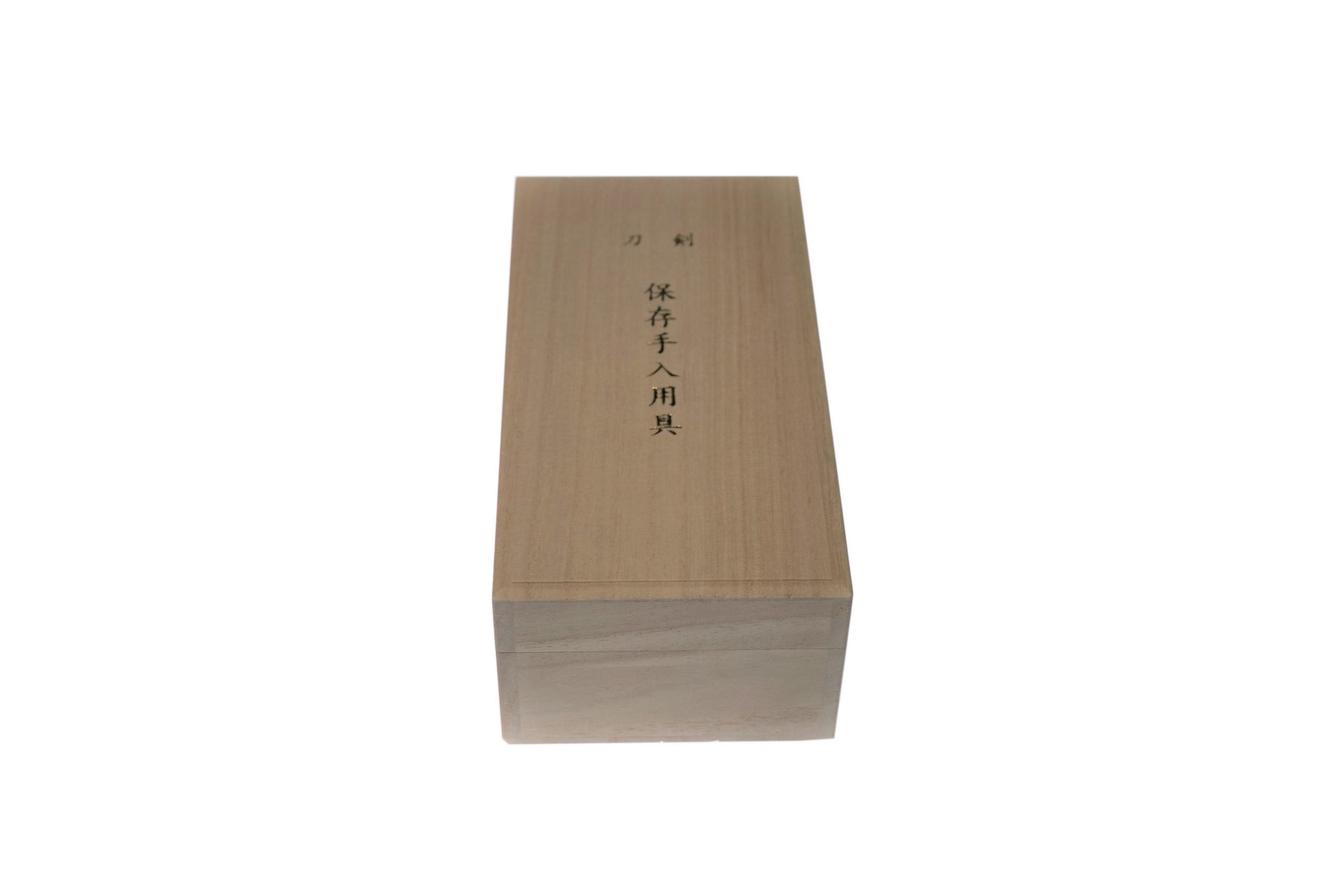
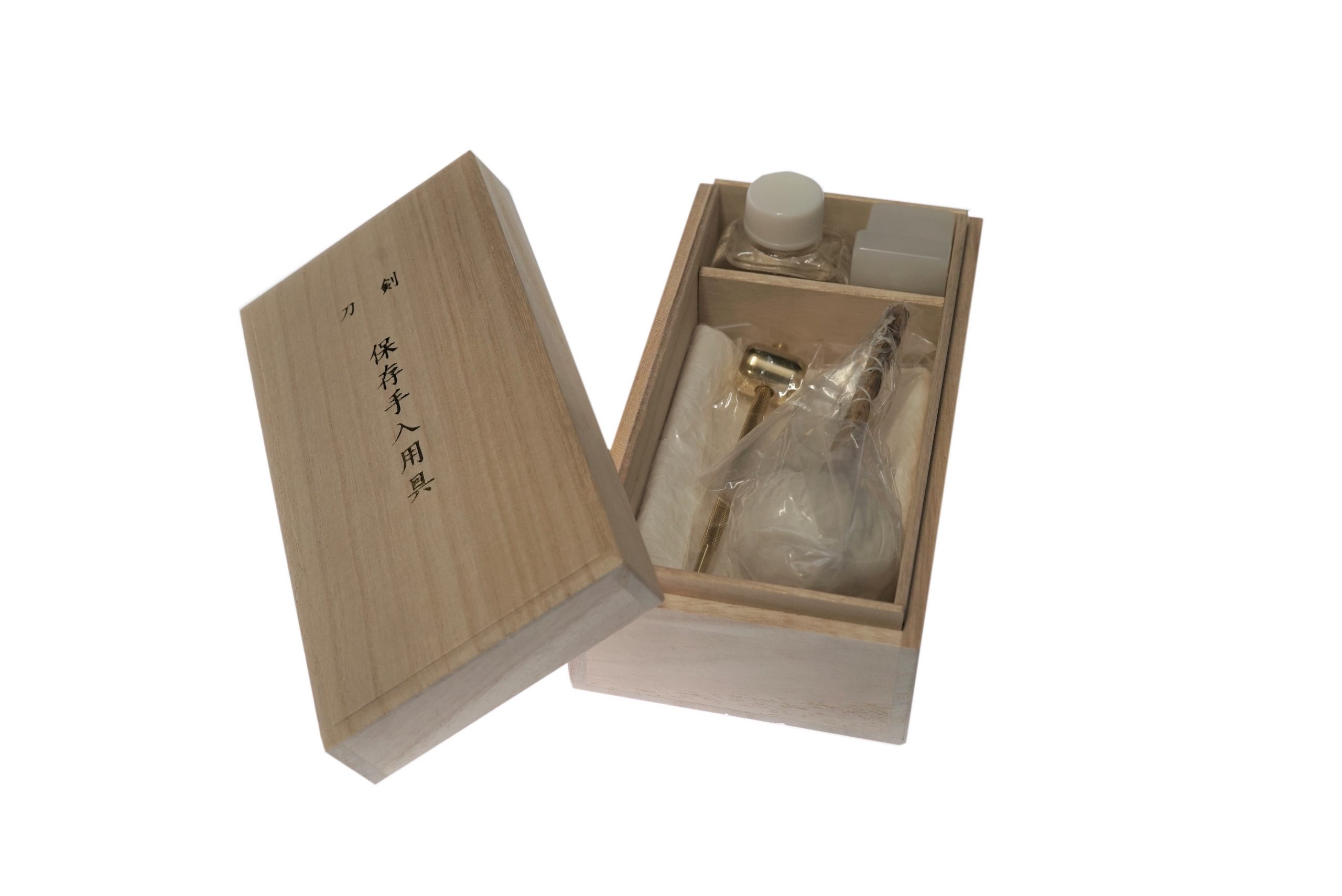
MORE ANTIQUE JAPANESE SWORD FOR SALE
SWORDS WITHOUT CERTIFICATES FOR SALE
LEARN JAPANESE SWORD TERMINOLOGY
Thank you for reading all the information on the page. If you have any difficulty choosing the right Japanese sword for you, we will be more than happy to help you find the one that speaks to you the most. Please feel free to contact us.
